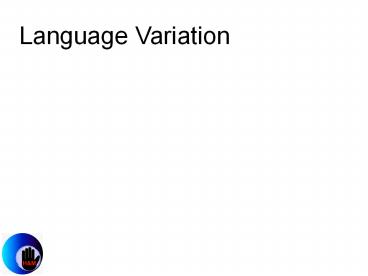Language%20Variation - PowerPoint PPT Presentation
Title:
Language%20Variation
Description:
Ceil Lucas and Clayton Valli (1992) Language Continua: ASL and English. Review Questions ... 4. Which level of the linguistic pyramid was the focus of the first ... – PowerPoint PPT presentation
Number of Views:107
Avg rating:3.0/5.0
Title: Language%20Variation
1
Language Variation
2
Language Variation by Community
Membership Dialect Variation Across
Regions Sociolect Variation Across Social
Classes Chronolect Variation Across
Time/Generations Genderlect Variation Between
Genders Ethnolect Variation Between Ethnic
Groups
Most Frequent Points of Variation Vocabulary
and Pronunciation
3
Register Variation Whos Talking to Whom? What
are the Talking about? Where is the Talking
happening? How is it Happening? (sound, image,
texture)
Common Linguistic Changes Lexical - Word
Choice Syntactic - Word Orders
Common Paralinguistic Changes Volume / Signing
Space Pitch / Facial Expression
4
Idiomatic Language Use Native Pronunciation Regi
ster-Appropriate Vocabulary, Syntax
Sociolect Matching Pronunciation Lexical
Choice Paralinguistic Features Volume Speed
Pitch / Tone
5
Language Contact Code Switching - Changing
Languages Code Mixing - Merging Languages
Traditional ASL/English Continuum
6
(No Transcript)
7
(No Transcript)
8
Contact Signing Ceil Lucas and Clayton Valli
(1992)
9
Language Continua ASL and English
10
- Review Questions
- 1. What four variables influence the development
of sociolects? - 2. What is the difference between sociolects and
dialects? - 3. What year did William Stokoe first identify
variation in ASL? - 4. Which level of the linguistic pyramid was the
focus of the first study of American Sign
Language? - Identify the three phrases other than Contact
Signing which have been used to describe
language contact between ASL and English. - 6. What label did Woodward develop and why is
that label now understood to be inaccurate? - 7. What was the primary flaw with attempting to
represent language contact between ASL and
English with a single continuum line? - 8. Where are complex grammatical structures of
ASL and English located on the revised
ASL/English continua? - 9. What are the three descriptors used to define
the space between ASL and English within the
revised ASL/English continua? - 10. Flanagan et. al. (1995) identified the
occurrence of true Foreigner Talk within ASL.
How is Foreigner Talk different than Contact
Signing?
11
- Suggested Activities
- Think of a common childrens story, such as
Goldilocks and the Three Bears, and tell it (in
either a signed or spoken language) as though you
were from another part of the country using a
different dialect of the same language. Try
telling the story again using different
sociolects of the same language (class, gender,
ethnicity, generation). Tell the story in
different registers, as though it were a news
report, a play-by-play sports broadcast, a
suspense-filled mystery, or an academic lecture. - 2. Observe three different examples of
communication in very different settings (such as
a church, a grocery store, and a classroom).
Identify at least ten ways that each kind of
communication is different from the other kinds
(including gestures, postures, pronunciation
differences, vocabulary choices, and complexity
of grammar).































